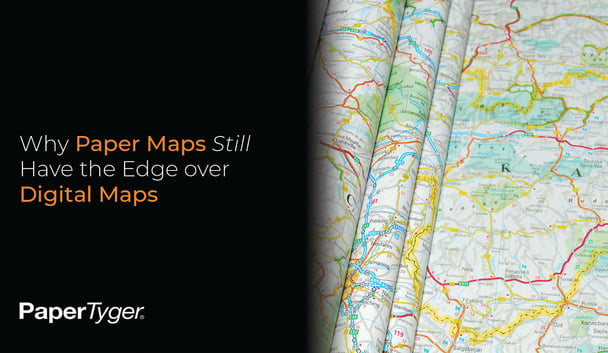In an age dominated by technology, it's easy to overlook the enduring appeal of paper maps. While...
Why Paper Maps have the Edge over Digital Maps

We live in an era where we have access to more information than ever. With the development of digital maps (including Google, Apple and GPS), you might think that the age of paper maps is over. But there are many reasons paper maps are still relevant in modern times and still in high demand.
Paper maps still Matter
Paper maps are still a requirement for many operations. For example, many people and businesses use paper maps as the preferred medium for planning and executing navigation. This includes national parks, tourist hotspots and ski resorts for trail maps. The best example of this comes from military use.
The U.S. Navy, for instance, trains recruits in celestial navigation as a security measure against the threat of digital grid hacking. Truck drivers and emergency service workers ensured they had paper maps in the front seat of their vehicle for the same reason.
There’s scientific backing for all this as well. It’s highlighted that those who rely exclusively on navigational technologies may be missing out on the low-tech benefits to the brain gained when using printed maps.
Paper Maps are Reliable:
No Signal or Battery Required!
What happens when our devices fail us? How do we navigate without them?
Yes, paper maps are still useful for navigation. Paper maps provide detailed directions that are easy to follow, while digital maps often rely on satellite images that aren’t always accurate. This is especially true when your device is lacking a good connection or battery power!
How fast does your phone pull up information deep in the woods? Most people would say poorly, if at all! So when you’re stuck and searching for help, it’s awfully unhelpful if your search takes dozens of minutes to pull the most basic information.
We want information at our fingertips. We often associate convenient information with digital means. But for specific locations, especially ones with unstable or nonexistent internet access, "at your fingertips" means physical not digital. Until everyone carries both a computer and a satellite in their pockets, paper maps will always be the safest guarantee.
Paper maps are Customizable
One of the biggest benefits of paper printing comes from the complete control companies have over their final product. Go ahead and search Google Maps for a detailed ski lift map of any major ski mountain. You simply won’t find quality results because Google Maps is a highly standardized product: standardization is essential to how all-encompassing these maps are.
All street information falls under strict buckets of information. Printing location-specific information or graphics is not supported by Google Maps’ structured format (save for things pulled directly from Yelp).
When locations have the freedom of control over how paper maps are designed, they can include relevant information that is inaccessible within the limitations presented by digital maps. Do you have a state bird, mascot, or logo you wish was represented on your map? This can only occur when you have complete freedom over map design; something that is impossible when using Google Maps or an equivalent, digital service.
Paper maps are Durable
For the outdoor adventure types and experts practicing in the field, a durable paper map can be a literal lifesaver! Most phones are not waterproof, or even water-resistant. So when (not if) that downpour starts, a durable paper map is a necessity.
I hear your concerns already, "but paper doesn’t hold up well in water!" This is true for most papers, but not PaperTyger paper.
Related Article: How Waterproof Paper Works
PaperTyger laminated paper is real paper—real paper designed with advanced, synthetic properties. Synthetic papers protect printed content against stains, spills, moisture, rips and tears, and contaminants (like oil, grease, and dirt). But synthetics can’t print in qualities as high as standard paper. PaperTyger paper is as durable as the synthetics, all while it prints as well as natural paper. That’s because (again) PaperTyger is real paper.
When applications invest in the right paper, maps can be better protected from harsh environments than, say, an iPhone. Durable paper like PaperTyger is a preferred (and cost-effective) solution for physical applications, like maps that require protection from brutal environments.
Related Article: 3 applications that should use durable paper
Interested in using PaperTyger paper for your maps?
Contact one of our paper experts to find out which would best suit your application.







